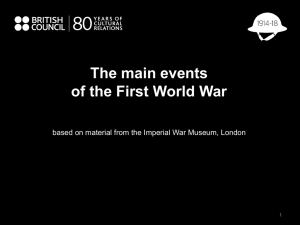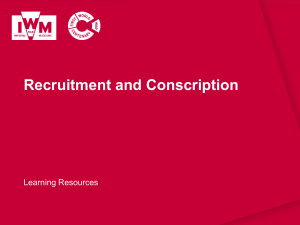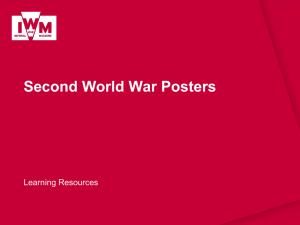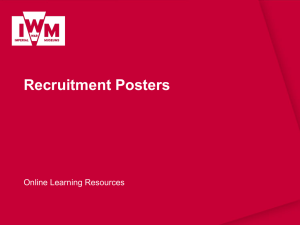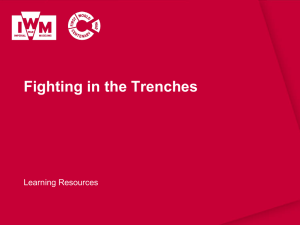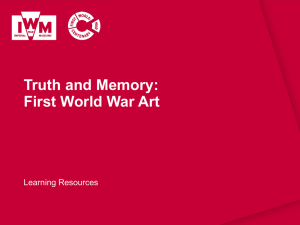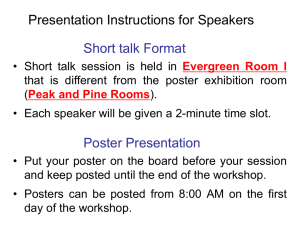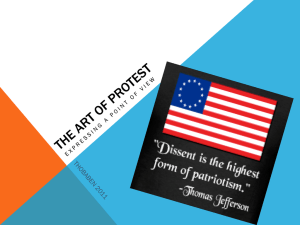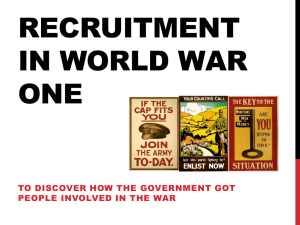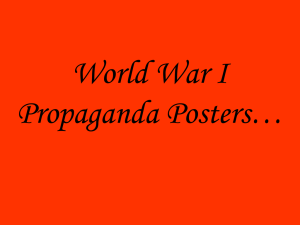Recruitment Posters
advertisement
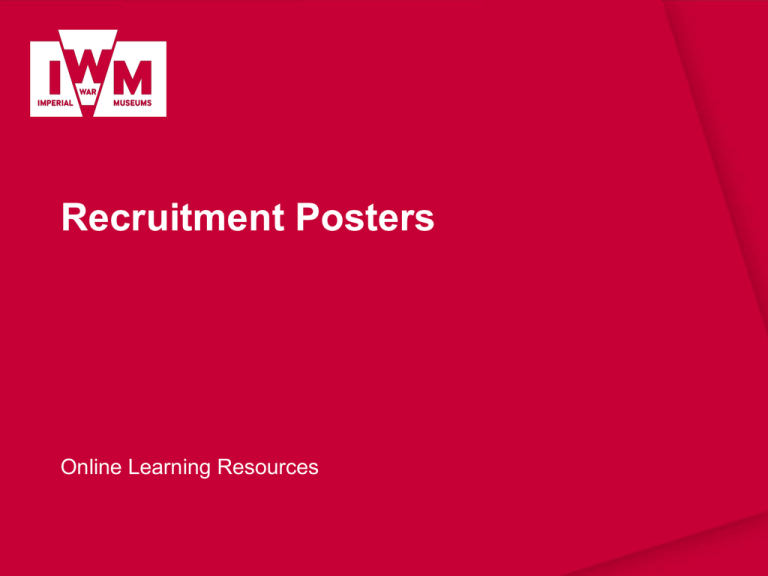
Recruitment Posters Online Learning Resources IWM Learning Resources: Terms of Use • The images in this resource can be freely used for non-commercial use in your classroom subject to the terms of the IWM’s Non Commercial Licence: http://www.iwm.org.uk/corporate/privacy-copyright/licence • You can use the full presentation or use individual slides within other presentations for use within school and to share with other teachers for their non commercial use as well. • You can print the images out up to A4 size if you wish to use hard copies with your class. • Each image comes with an attribution statement, which must be included wherever the image is used. For example, © IWM (Art.IWM ART 1179). • Every effort has been made to contact all copyright holders. IWM will be glad to make good any error or omissions brought to their attention. • By downloading this PowerPoint and using these images you agree to these terms of use, including your use of the attribution statement specified for each object by IWM. © IWM (Art.IWM PST 2734) Britons. Join Your Country’s Army! This is perhaps the most famous poster from the First World War, and shows Field Marshal Lord Kitchener, appealing for people to join the British Army. It was first produced in 1914, but has taken on a more iconic status since the war, when it was not widely circulated outside of the London area. However, its striking visual appeal was picked up by other artists, including in the USA, where the image of Kitchener was replaced by Uncle Sam. © IWM (Art.IWM PST 2763) Women of Britain Say 'Go!' This poster clearly demonstrates the application of commercial advertising techniques to the recruitment campaign and is appealing to Britain’s female population to encourage more men to join the army, whilst depicting women and children as needing protection. However, The First World War substantially increased the numbers of women in paid work and the range of jobs that they undertook. © IWM (Art.IWM PST 5476) WOMEN URGENTLY WANTED FOR THE W.A.A.C. The Women’s Army Auxiliary Corps (WAAC) was established in December 1916. Women who joined the Corps carried out a large number of non-combatant tasks in France, freeing up more men for service in the front line. The first party of 14 women arrived on the Western Front on 31 March 1917. Eventually, 9,000 women served with the unit in France. © IWM (Art.IWM PST 2712) Are You in This? This poster was designed by Robert Baden Powell who established the Scouting movement. It shows how different sections of society are contributing to the war effort, including a scout. On the side lines is a man shown with his hands in his pockets, and smoking a cigarette, who is not yet involved. © IWM (Art.IWM PST 0318) Step Into Your Place This poster shows a united Britain, with all members of society going to war together. Everyone is shown carrying the tools of their trade or profession, with civilians gradually transforming into British infantrymen. © IWM (Art.IWM PST 12226) Sportsmen's One-thousand The idea that team sports were good preparation for war was common across Britain and it’s Empire. Team sports incorporated both team spirit and a sense of patriotism and this Australian poster plays on the country’s sporting pride and its growing sense of identity. © IWM (Art.IWM PST 12580) This Soldier is Defending India This Indian recruitment poster was produced with a blank strip at the bottom, so that each region could add text in their own language. This made the poster very flexible, as it could be adapted to meet the needs of the area it was going to. However, recruitment posters were less common in India, where the recruitment campaign was conducted differently. India was still a largely rural society at this time and poster campaigns were more associated with urban areas. © IWM (Art.IWM PST 3242) ? [The Question Mark] This poster was designed for the last recruiting campaign carried out by the Government of Australia during the First World War. It shows an ape-like monster, wearing a German helmet, or pickelhaube, which was seen as a symbol of German militarism. The poster was part of a sophisticated campaign, and the graphic imagery is particularly forceful and very different to that used in British posters. © IWM (Art.IWM PST 8712) New Germany This striking poster imagines an Australia occupied and taken over by Germany. This was never a realistic fear for the people of Australia, but rather reflects the fear of a world dominated by Germany and the values it was perceived to have. © IWM (Art.IWM PST 13654) Irishmen Avenge the Lusitania The passenger liner RMS Lusitania was torpedoed and sunk by a German U-boat in May 1915. The ship may have been carrying military supplies, but over 1000 passengers lost their lives in the incident, which became one of the most controversial acts of the war. This poster uses the incident to try and encourage Irish men to enlist, and avenge the sinking of the ship. © IWM (Art.IWM PST 5109) Remember Scarborough On the morning of 16 December 1914, the North Sea ports of Hartlepool, West Hartlepool, Whitby and Scarborough were bombarded by the German First High Seas Fleet Scouting Group. 137 people lost their lives and 592 people were wounded. This poster uses the incident to try and encourage people to enlist, but the British public and newspapers were also outraged at the Royal Navy for not protecting the towns. © IWM (Art.IWM PST 13658) For the Glory of Ireland This Irish recruiting poster uses the German invasion of Belgium as a recruiting tool. It is appealing specifically to the Catholic population of Ireland, which at this time was still part of the United Kingdom, to defend Belgium, which was also a Catholic country. © IWM (Art.IWM PST 13632) Who Can Beat this Plucky Four? This poster from 1915 shows English, Scottish and Welsh troops crouched, poised and ready for war, whilst an Irish soldier stands behind them. The poster was used in Ireland, where much of the country was pursuing independence, to encourage men to enlist and join the war effort. In this instance the poster was particularly aimed at the Protestant population and those supporting unionism. © IWM (Art.IWM PST 5031) FORWARD! This poster was produced in September 1915 and was the last one to make use of an image in the recruitment campaign. By the time it was produced enlistment numbers had fallen and the introduction of conscription was inevitable. However, posters like this were still used to encourage people to enlist before they became conscripts. © IWM (Art.IWM PST 5161) The Military Service Act This poster announces the military service act, which introduced conscription in 1916. It sets out the facts of this new piece of legislation and encourages men to enlist before the act came into force on March 2nd. With the introduction of the act, posters became more about providing information, than trying to be persuasive. © IWM (Art.IWM PST 0888) Your King and Country Need You! This poster is appealing for people to enlist with the Quebec Rifles as part of the Canadian Expeditionary Force. It shows the four allies of Belgium, France, Russia and Britain and, despite the posters title, is encouraging people to join an international war effort and fight for universal values and causes. © IWM (Art.IWM PST 13448) Vote for Snowball and No Conscription Conscription in Britain was first introduced in 1916, but remained unpopular throughout the war. This poster date from the 1918 general election and shows that people were still unhappy with being forced to join the armed forces. Recruitment Posters Online Learning Resources
